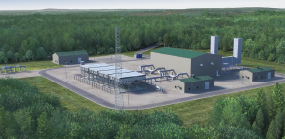Convergence is the implementation of technology gains and other innovations across an energy consuming market.
Convergence in this study is more specifically defined as:
- The continuous progression of the natural gas and electric industries from separate and distinct operating markets to a consolidated dynamic market driven by competitive forces and new technologies.
The INGAA Foundation asked us to determine the following:
1. Will convergence occur?
2. Is convergence good or bad for the natural gas industry?
Conclusions
In our estimation, the gas and electric industries in the United States are anywhere from one-half to two-thirds of the way through convergence. Commodity and organization (consolidation) convergence is well underway, and service convergence is beginning. Business process convergence, which will complete the cycle, is on the drawing boards. Under ideal circumstances, full convergence will take another decade or more. As discussed below, circumstances are not ideal.
The convergence that is occurring is generally good for the gas industry because it has the potential to increase gas demand, including the demand for energy services. The issue now will be whether gas can be delivered economically to converged retail markets.
Convergence in today’s environment makes us bullish on natural gas demand growth. We found no evidence that the natural gas delivery system will be unable to keep pace with convergence-driven changes in other industry segments. However, with this potential increase in natural gas demand and with industry deliveries reaching the capacity peak of the early 1970s, we conclude that there will be an upturn in pipeline construction. This will be particularly true in urban areas as generation technologies ove electric generation closer to the market and in southern markets where summer eak is exceeding the winter peak.
Pipeline construction also will increase in the supply basins (Deepwater Gulf of Mexico, Rockies, Western Canada, North Atlantic) needed to meet these additional requirements. Convergence is not expected to put additional impetus on the West-to-East pipeline investments currently under way, but it should improve the performance of those projects once completed.
Convergence is being slowed by a number of incumbent forces, and the reduced pace is a potential cost to the gas industry.
a) MARKET DEFINITION: Retail energy markets continue to be separate and distinct. Price elasticity studies for natural gas and electricity indicate that demand for the two sources of energy is nearly independent in residential and commercial markets.
b) ELECTRIC INDUSTRY RESTRUCTURING: Investments in fuel-specific equipment and the interim effects of stranded costs can inhibit an electric utility’s behavior to adopt new technologies and service options to meet the market’s new requirements.
c) REGULATION: To the extent regulators do not allow market-driven regulations in place of cost-based pricing and other non-market-driven techniques, these reforms discourage the development of services and create inefficiencies in the use of industry resources.
d) GAS INDUSTRY OPERATIONS: Although the existing natural gas pipeline infrastructure continues to add operational flexibility to allow pipelines to better match the cycling requirements of gas-fired electric generation, further flexibility in scheduling and nomination processes is necessary to meet service requirements for power generators.
Role of Natural Gas in Convergence
Compounding our analysis is the fundamental fact that natural gas today has a unique role as both a supporter of and a competitor to electricity. Natural gas is a fuel source for electricity and is also a competitor with electricity in a number of end-use applications. Development of the "multi-service company " – an energy company that can provide gas, electricity or other fuels and energy-related services as a customer chooses – has the potential to eliminate some of this dysfunction as customer technologies become the value-drivers.
Strategies for Natural Gas
There are actions the industry members can take to improve their position in the evolving gas market. In our overall opinion, the most successful infrastructure strategy for a company will be to develop an operation and service portfolio that is not directly linked to changes in fuel commodity and infrastructure capacity costs. This will enable companies to deliver increasingly innovative products and services to a waiting market.
Our research identified a number of strategies in progress across the industry to effectively meet the challenges of the new environment.
Natural Gas Service Strategies
1) Develop relationships necessary to support new market entrants as they move to become electric generators and begin to market electricity directly to end-users.
2) Expand storage and line pack capabilities to provide competitive service for electric generation requirements and operating capabilities to compete for peaking use of natural gas in electric generation.
3) Create nomination processes that align natural gas delivery more closely with electric generation requirements. The process should allow shippers to respond to gas price movements.
4) Develop monitoring and data gathering system applications and processes that provide the pipeline and its customers with the ability to rapidly respond to changing electric and gas demand.
5) Provide capital and financing incentives for equipment purchases for expansion in co-generation, repowering or infrastructure development to industrials, generators, commercial and residential end-users.
6) Support more distributed combined cycle generation to support growth requirements for electric utilities.
Rate Methodology and Pricing
7) Support more flexibility in negotiated services for interstate natural gas pipelines so that natural gas can meet power generation requirements and enhance the ability of natural gas to compete with alternate fuels in electric generation.
8) Promote rate and contract flexibility for off-peak service to capture market share. Electric generation requires daily and seasonal swings that do not generally use peak day facilities. Therefore, pricing strategies should accurately price these off-peak swings in load (off-peak balancing rates, etc.)
Technology
9) Create consumer-friendly efficient gas appliances and equipment for the end-use sector, where the primary decision is equipment, not fuel.
10) Support gas reburn and cofiring technologies to promote the use of natural gas in dual-fuel burning industrial boilers.
11) Participate in the development of distributed power programs pushing the use of natural gas to generate electricity.
12) Encourage the development of fuel cell technology, promoting its significantly improved reliability, efficiency, and scalability.
13) Develop real time computer systems with coordination models between natural gas prices and electric prices.
Market Entry and Access
14) Support regulations and laws that create or support competition between natural gas and electricity by mandating equal access to energy sources to promote customer choice.
15) Work with federal and state regulators to develop an expedited certificate process to allow timely expansion of pipeline infrastructures.
STUDY APPROACH AND ORGANIZATION
To addresses the issues raised by convergence, we evaluated nine specific hypotheses on the impact of convergence on participants in the natural gas industry. Section I of this report provides an introduction and outlines the scope of the study. Section II maps the role of natural gas in the electric industry. Section III summarizes the conclusions. Key findings of our research are in Section IV, with an expanded discussion of the research provided in Part Two of this report.



